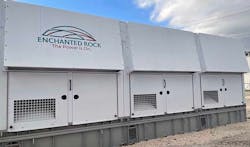Flexible Capacity: The Secret Weapon for Securing Interconnection
Facing an increasingly unreliable supply of electricity, utilities have begun limiting — out of their own necessity — new interconnection processes for energy-intensive facilities. Many have even gone as far as implementing interconnection queues to manage new requests, which result in substantial delays in getting connected to the grid. While extremely frustrating, utilities aren’t to blame. In a lot of areas, there’s just not enough electricity to accommodate existing communities and businesses, as well as new power-intensive operations such as data centers, advanced manufacturing facilities and EV charging stations. The onus, then, is unfortunately on data center owners and operators to overcome the grid capacity problem if they want access to allocated power without timeline overruns.
Recognizing that electrical generation constraints are at the heart of the problem, innovative data centers are embracing a new mechanism called “flexible capacity,” which utilizes on-site microgrids with grid-independent power sources such as natural gas generators to boost data center and grid-wide resiliency. When a utility’s supply of electricity is running low, facilities equipped with flexible capacity can activate their systems, which allow operations to continue with a reduced dependence on power from the grid. In some cases, this power can even be fed back to the grid, not only reducing demand but increasing supply.
Essentially, then, adopting flexible capacity turns data centers into distributed energy resources, which is exactly why utilities are keen on approving equipped projects. The on-demand nature of flexible capacity supports the wider wholesale market in ways that alternative energy solutions — like large-scale renewable integration — simply can’t. Ultimately, this incentivizes utilities to approve data centers with flexible capacity, making it key to the continued growth of the data center market.
Flexible capacity also provides a critical benefit to data centers themselves — the ability to operate independently of the grid. This means that if an outage does occur, flexible capacity can be leveraged to ensure a data center’s power supply remains uninterrupted. This “islanded mode,” as it’s colloquially referred to, creates additional value by ensuring data center infrastructure remains protected at all hours of the day. For this mission-critical industry, this resiliency is invaluable.
An ultra-clean natural gas microgrid can not only give you the flexibility to support the local grid, but it can also support the grid for 300-400 hours per year while still having lower onsite emissions than its diesel counterparts that operate less than 100 hours per year. Due to the local and climate pollutants produced by diesel generators, efforts to approve the use of diesel generators for grid support were recently rejected in Loudoun county, Virginia. A much more inviting alternative would be utilizing systems that are powered by low-emission solutions that can have a significant impact during emergency scenarios.
Local communities are also key beneficiaries of flex capacity. Not only will these microgrids be quieter and cleaner than incumbent technologies, but they will support the resiliency of local homes and businesses. Outages can have significant negative impacts on families and business operations, and the need for a reliable grid is paramount. As dual purpose microgrids support grid resilience, local utility customers can also enjoy the accompanying peace of mind.
Data centers are uniquely positioned to leverage the advantages of flexible capacity, as they align closely with two of the industry’s most pressing issues: reducing project-to-market timelines by overcoming interconnection hurdles and boosting on-site resiliency by hedging against grid outages.
Competition for electricity is fierce right now, and data centers need every advantage available to them. Owners and operators looking to get allocated power without extensive delays would be wise to adopt flexible capacity as a means of overcoming the regulatory limbo that often claims large-scale projects. Flexible capacity, then, will be key to supporting new data centers in high-demand regions for years to come.
Brian Jabeck is Vice President of Data Centers at Enchanted Rock. Contact them to learn more about their natural gas microgrid solutions.



